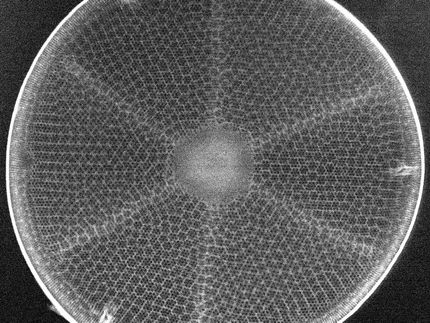Novel 3D printed polymer lenses for X-ray microscopes: highly efficient and low cost
Scientists at the Max Planck Institute for Intelligent Systems in Stuttgart invented a new and cost-effective method for making X-ray lenses with nanometer-sized features and excellent focusing capabilities. By using an advanced 3D printing technique, a single lens can be manufactured under a minute from polymeric materials with extremely favorable X-ray optical properties, hence the costs of prototyping and manufacturing are strongly reduced. High-throughput and high-yield manufacturing processes of such lenses are sought after world-wide, which is why the scientists have filed a patent for their invention.
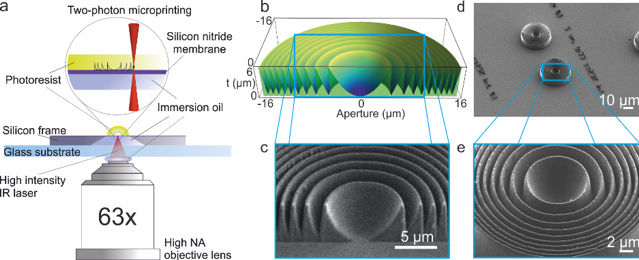
Overview of the fabrication method. The micrographs are imaged by a scanning electron microscope.
Umut Sanli
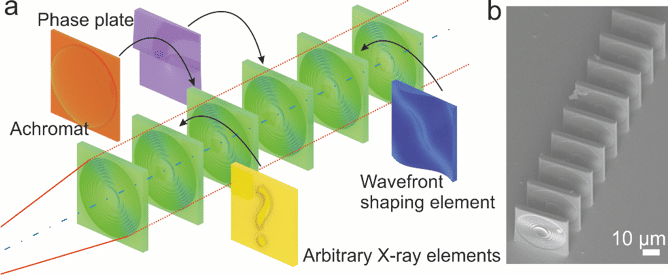
3D nanoprinting of a new type of polymer X-ray optics.
Umut Sanli
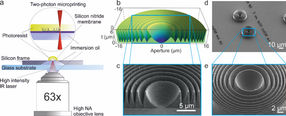
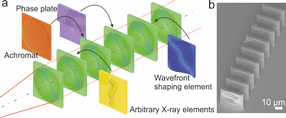
X-ray microscopes are fascinating imaging tools. They uniquely combine nanometer-size resolution with a large penetration depth: X-ray microscopy or XRM is the only technique where one can study buried features at high resolution. With XRM one can for instance see the defects inside a computer´s central processing unit without destroying it, make micro machinery visible under working conditions, and study organelles in a cell in their natural environment.
However, focusing of X-rays is no easy task and requires optics with extremely challenging nanoscale geometries. Owing to their complex nanofabrication method, a single lens can cost up to several tens of thousands of Euros.
A collaboration between the Modern Magnetic Systems and the Physical Intelligence departments at the Max-Planck-Institute for Intelligent Systems in Stuttgart led to the invention of a new and less-expensive method for making 3-dimensional Kinoforms – converging lenses that are able to efficiently focus X-rays. They 3D-nanoprinted this diffractive X-ray optic. “We used a femtosecond pulsed infrared (IR) laser, and a photoresist that can polymerize by absorbing multiple infrared photons simultaneously to write structures smaller than the wavelength of light”, Umut T. Sanli explains. He is a Ph.D. student in the Micro/Nano Optics group, which is a part of the Modern Magnetic Systems Department, led by Gisela Schütz. Sanli is the lead author of a study which was recently published online in the Advanced Materials journal. “This way, we achieved an extremely challenging X-ray lens geometry with nanometer-size features and very high focusing efficiencies,” he continues.
The X-ray optics of XRMs usually need to be replaced every year, if not more often, due to radiation damage. There are also experiments that require scores of lenses for focusing the extremely brilliant X-ray beams of the recently developed free electron lasers (FEL), where a lens is usually destroyed in a single pulse. Therefore, high-throughput and high-yield manufacturing processes are sought after worldwide. “Selecting the right materials is a crucial part of the manufacturing process” explains Kahraman Keskinbora, who leads the Micro/Nano Group. He and his team chose two-photon polymerization (2PP) polymers to fabricate X-ray lenses. “We realized that the 2PP-polymers come with extremely favorable X-ray optical properties that could only be matched by Beryllium – a highly toxic element – and Diamond, which is very expensive.” Also, Beryllium and Diamond are both very difficult to shape into the required 3D profiles at the nanoscales. “With the new invention, the printing of a lens takes less than a minute and therefore, the costs of prototyping and manufacturing of X-ray lenses are strongly reduced. Additionally, the polymer lenses are safe to manufacture and once optimized, the fabrication is straightforward,” underlines Hakan Ceylan, a postdoctoral researcher in the Physical Intelligence Department, which is led by Metin Sitti.
“We went one step forward by combining several of the lenses in series. By integrating various optics, we can effectively control and manipulate the X-ray wavefront. With several lenses and other wavefront shaping elements positioned one after the other, we can optimize these integrated X-ray optics for even the very hard X-ray energy range,” Keskinbora projects. “So, there are a lot of new research venues to follow.”
The researchers have filed a patent application for their invention with the help of Max-Planck-Innovation.
